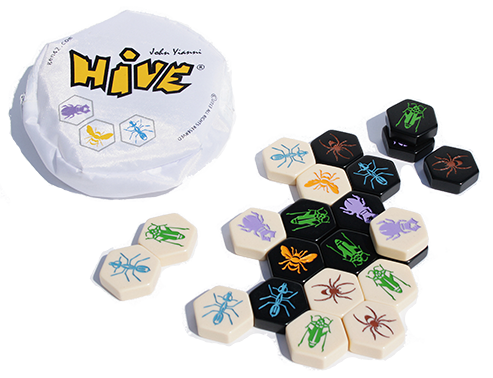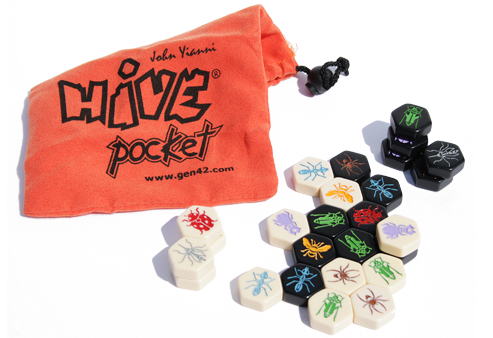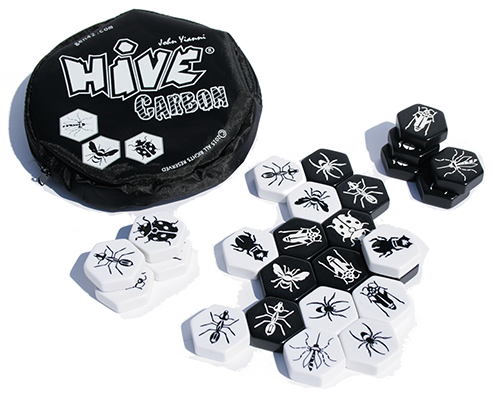The Hive Board Game – It’s Not Chess, No Questions Asked
The Hive Board Game

Details
| Player Count | Playing Time | Age |
| 2 Players | 20 Minutes | 9+ |
Description
The Hive board game is a highly addictive strategic game for two players that is not restricted by a board and can be played anywhere on any flat surface. With no setting up to do, the game begins when the first piece is placed down. As the subsequent pieces are placed this forms a pattern that becomes the playing surface (the pieces themselves become the board). Unlike other such games, the pieces are never eliminated and not all have to be played. The object of the game is to totally surround your opponent’s Queen Bee, while at the same time trying to block your opponent from doing likewise to your queen. The player to totally surround his opponent’s Queen Bee wins the game.
The Hive Board Game FAQ can be found here.
Setup For The Hive Board Game
- Give each player their tiles.
- Decide with which expansions (if any) you choose to play.
- Is there a level playing surface nearby? Table? Empty chair? Maybe a nice piece of paving? Good. Let’s go.
Playing The Hive Board Game
On your turn you have one of two decisions: Place a piece or move a piece.
Place a piece: The new piece may only touch your own pieces. The Bee has to be one of the first 4 pieces to be placed and you’re not allowed to move pieces until the Bee is placed.
Move a piece: Each piece has its own way of moving, same as in Chess. A piece can occupy any position on the board, provided it can legally reach that spot without moving other tiles out of the way to get there. Most importantly, you’re never allowed to move a piece if doing so would break the hive apart, even if placing it back would reconnect everything. This becomes important as you learn the game.
- Ant: Move anywhere around the outside of the hive
- Spider: Same as the Ant, but exactly 3 spaces forward or backward. No more, no less.
- Grasshopper: Can move across the hive in a straight line to the next open spot in that direction. It must be in a straight line and it can’t move over an empty space without ending its move. This means the grasshopper can get into and out of single spaces without moving tiles.
- Bee: A single movement in any direction, provided it can do so without moving other pieces out of the way.
- Beetle: Like the Queen Bee, the Beetle can only move a single space at a time. The difference is that the Beetle can move on top of the hive, covering other tiles. When the Beetle is on top of a tile, that space is considered to be the colour of the Beetle for the purposes of placing new tiles.
There are expansion pieces that are optional. For those instructions see below.
Emergent Gameplay
What makes Hive so fascinating is how intricate and complex a game can become, based on these simple rules. Because there’s no fixed board, a piece can never be trapped in a corner. Players can choose when to deploy their Queen Bee and which pieces are in play when it does, effectively setting up an opening strategy. The simple movesets and number of pieces can feel limiting until you take into account that pieces have six sides instead of only four, but that they move along the outside edges instead of straight lines (mostly). I often find myself staring at the board trying to decide what the best move would be, only then to remember I have pieces in reserve. Hive is the very definition of “easy to learn but hard to master”.
One of the best parts of the game, especially of the Pocket Edition, is the incredibly tiny footprint! The game comes with a cloth bag to store it in! I call these types of games “glovebox games”, to be brought out at a restaurant, a gathering with friends, or even at the beach. It’s also attractive on the table (or sand?) and gets people interested. It’s a great conversation starter!
No matter how you look at it, Hive is a great two-player game at a reasonable price. It’s quick enough to get regular play time but has enough depth and complexity to keep players interested.
FAQ
How do you play the game Hive?
The full rulebook for Hive is available on their website. I call it a rulebook but in reality, it’s more of a pamphlet. This is a very simple game.
Is Hive a solved game?
I don’t know if the game is popular enough for any person to do the calculations on it, but I’m quite sure Hive is less complex than Chess but probably more complex than Checkers. Intuition tells me that it would be possible to calculate every possible game state, even if they don’t make any sense in context. So TL;DR: yes Hive is theoretically a solved game.
What does the ladybug do in Hive?
Hive has three expansions, each adding a new piece for both players to use when they choose:
- Ladybug is a combination of the Beetle and the Spider. It moves exactly 3 moves at a time, over the hive. A very important rule is that the ladybug may never end its move on top of the hive. We normally teach it as “on, on, off.”
- Mosquito is a doozie. It copies the ability of one of the pieces it is touching. The number of tactical decisions go up exponentially when the mosquito is in play, so it’s not recommended for first time players.
- Pillbug is the only expansion that must be bought separately (as the other two are included in Pocket Edition). It allows a piece to be lifted over itself and placed on any of the other 5 sides, provided doing so won’t break the hive.
What is the difference between Hive and Hive pocket?


Hive Pocket has smaller pieces and includes the Ladybug and Mosquito. This is good and bad. In terms of gameplay options, Hive Pocket is the more affordable game and can be played with one or both of the expansions, giving more variability. However, the smaller pieces mean it doesn’t tolerate uneven play surfaces very well.

There’s also a Carbon Edition of Hive, which is the same size as the normal version but is completely black and white. I thought it would be a nicer, classier version of the game to own but very quickly realised the lack of colour makes it difficult to tell the tiles apart. The ivory of the original tiles also lends the feel of an older, more vintage game, like the aged keys of a grand piano. Only purchase Carbon Edition if you’re sure that the look is important.
Who goes first in Hive?
From our play experience there’s a first player advantage, although the ability to choose when the Queen Bee is placed heavily mitigates this effect, so it really doesn’t matter. We recommend playing best out of three games with the loser going first for successive plays.
How do you win the Hive?
The win condition is the completely surround the opponent’s Queen Bee on all six sides. It’s important to note that all the surrounding pieces don’t have to be your own.
How do you play Hive like a champion?
The best way to get better at Hive is by building a small group of players that play against each other regularly, sort of like a chess club. This way the players all improve at the same rate and teach each other better tactics and strategies. There’s also a strategy guide available but I can’t comment on its effectiveness.
A few pointers to improve your play:
- As mentioned above, the pieces surrounding the Queen Bee for the win don’t all have to be the opponent’s pieces. It’s possible to get the Bee trapped inside its own pieces.
- The Queen Bee can’t move if doing so would break the hive, so it can be pinned by moving a piece to its opposite side, making sure that the only piece it is touching is the Bee. This will force your opponent to spend a turn (or more) getting a piece in place to keep the hive attached.
- If the Beetle is on a piece, the piece can’t move. Use this to keep the Queen in one spot while you surround it. You can also use this trick to place new pieces next to the Queen Bee, seeing that it’s now your colour and not the opponents.
- The Spider can jump single space gaps along the outside of the hive. While counting the three moves out, a situation is created where the Spider is touching both the edges on either side of the gap and can then continue moving on the other side.
I use affiliate links throughout this post. It is what helps me do this.



1 Comment
Denver · December 30, 2020 at 3:25 pm
Thanks for your contribution to the site Zach. I really enjoyed reading this, and it makes me want to play another game of hive ASAP.
Comments are closed.